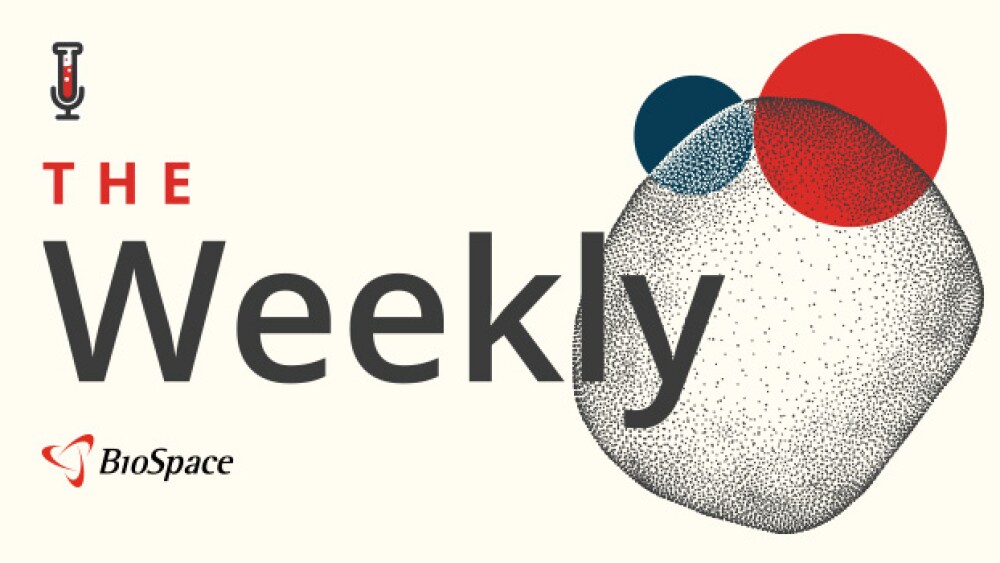Sumitovant Biopharma, Inc. today announced that its portfolio of four wholly-owned subsidiary companies (Urovant, Enzyvant, Altavant and Spirovant) and Myovant (NYSE: MYOV), a publicly listed company that is majority-owned by Sumitovant, achieved significant clinical, regulatory and commercial milestones during the company’s second quarter of fiscal year 2021 ending in October.
|
LONDON and NEW YORK, Dec. 10, 2021 /PRNewswire/ -- Sumitovant Biopharma, Inc. today announced that its portfolio of four wholly-owned subsidiary companies (Urovant, Enzyvant, Altavant and Spirovant) and Myovant (NYSE: MYOV), a publicly listed company that is majority-owned by Sumitovant, achieved significant clinical, regulatory and commercial milestones during the company's second quarter of fiscal year 2021 ending in October. "The second quarter of 2021 was marked by progress on significant regulatory milestones. Enzyvant gained FDA approval of RETHYMIC® for pediatric patients with congenital athymia, a rare immune disorder. Also, majority-owned Myovant received FDA acceptance of MYFEMBREE®'s supplemental New Drug Application in pain associated with endometriosis," said Myrtle Potter, CEO of Sumitovant Biopharma. "In addition, Sumitovant companies also made significant clinical contributions to the scientific community, with key data presentations at prominent medical meetings which continue to underscore the therapeutic potential of our collective pipeline in a variety of therapeutic areas with high unmet needs." Milestone Highlights Enzyvant On October 8, Enzyvant announced the U.S. Food and Drug Administration (FDA) approved RETHYMIC® (allogeneic processed thymus tissue-agdc), a one-time regenerative tissue-based therapy for immune reconstitution in pediatric patients with congenital athymia. Myovant On September 9, Myovant and its partner, Pfizer, announced that the U.S. Food and Drug Administration (FDA) accepted for review a supplemental New Drug Application (sNDA) for MYFEMBREE® (relugolix 40 mg, estradiol 1 mg, and norethindrone acetate 0.5 mg) for the investigational use of the management of moderate to severe pain associated with endometriosis. The FDA set a target action date of May 6, 2022 for the sNDA under the Prescription Drug User Fee Act (PDUFA). Additional Highlights Myovant On October 19, Myovant and its partner, Pfizer, presented data on relugolix combination therapy (relugolix 40 mg plus estradiol 1.0 mg and norethindrone acetate 0.5 mg) from clinical studies in uterine fibroids and endometriosis at the American Society for Reproductive Medicine (ASRM) 2021 Congress. The presentations included two-year efficacy and safety data in women with heavy menstrual bleeding associated with uterine fibroids and pooled safety and tolerability data. In August, the FDA informed Myovant that the partial clinical hold for the Phase 3 SERENE study evaluating relugolix combination therapy for the prevention of pregnancy was lifted following study protocol amendments. The amended SERENE study protocol will evaluate the contraceptive efficacy of relugolix-CT in women with heavy menstrual bleeding associated with uterine fibroids or endometriosis-associated pain who are 18 to 50 years of age and at risk for pregnancy, and includes bone mineral density monitoring for patients during and after treatment. Patient screening with this updated protocol began in September 2021, with initial patients dosed in October 2021. Urovant On September 13, Urovant presented at the 2021 American Urologic Association (AUA) annual meeting new data from a dedicated ambulatory blood pressure study showing that vibegron 75mg in overactive bladder patients was not associated with statistically significant or clinically meaningful effects on blood pressure or heart rate. In addition to this presentation, further data presented at AUA included a review of the efficacy of vibegron in the OAB dry population from the EMPOWUR phase 3 pivotal trial. Urovant also presented data collected from a Director of Nursing population related to the impact of overactive bladder on residents and caregivers in the long-term care community. These data highlights were presented at the National Association of Directors of Nursing Administration (NADONA) and the Gerontological Advanced Practice Nurses Association (GAPNA) annual meetings in September 2021. Altavant On September 13, Altavant presented an e-poster at the European Respiratory Society annual congress highlighting the protocol design of the ongoing double-blind, placebo-controlled ELEVATE 2 (NCI NCT04712669) Phase 2b study of rodatristat ethyl (rodatristat) in patients with pulmonary arterial hypertension (PAH). Enzyvant On August 26, Enzyvant announced data from two first-ever studies revealing extreme clinical, emotional, social, and financial burdens on pediatric patients with congenital athymia and their families, and extraordinary costs of supportive care to healthcare systems. Posters of each of the studies were presented at the Clinical Immunology Society 2021 Annual Meeting. On August 4, Enzyvant announced results from clinical trials of the Company's investigational RVT-802 (allogeneic processed thymus tissue-agdc), engineered human thymus tissue implanted in 105 pediatric patients, published in The Journal of Allergy and Clinical Immunology. Spirovant On October 28, Spirovant announced plans to deliver oral and poster presentations highlighting pre-clinical data for its compound, SP-101, an investigational novel recombinant adeno-associated virus (AAV) gene therapy selected for its tropism to human airway epithelia, at the 2021 North American Cystic Fibrosis Conference in November. About Sumitovant Biopharma Ltd. About Sumitomo Dainippon Pharma Co., Ltd. About Urovant Sciences About GEMTESA® GEMTESA is a prescription medicine for adults used to treat the following symptoms due to a condition called overactive bladder:
It is not known if GEMTESA is safe and effective in children. IMPORTANT SAFETY INFORMATION Tell your doctor about all the medicines you take, including prescription and over-the-counter medicines, vitamins, and herbal supplements. Know the medicines you take. Keep a list of them to show your doctor and pharmacist when you get a new medicine. What are the possible side effects of GEMTESA? Call your doctor for medical advice about side effects. You may report side effects to FDA at 1-800-FDA-1088. Please click here for full Product Information for GEMTESA. About Myovant Sciences About MYFEMBREE® For full prescribing information including Boxed Warning and patient information, please click here. Indications and Usage Important Safety Information CONTRAINDICATIONS WARNINGS AND PRECAUTIONS Bone Loss: MYFEMBREE may cause a decrease in bone mineral density (BMD) in some patients, which may be greater with increasing duration of use and may not be completely reversible after stopping treatment. Consider the benefits and risks in patients with a history of low trauma fracture or risk factors for osteoporosis or bone loss, including medications that may decrease BMD. Assessment of BMD by dual-energy X-ray absorptiometry (DXA) is recommended at baseline and periodically thereafter. Consider discontinuing MYFEMBREE if the risk of bone loss exceeds the potential benefit. Hormone-Sensitive Malignancies: Discontinue MYFEMBREE if a hormone-sensitive malignancy is diagnosed. Surveillance measures in accordance with standard of care, such as breast examinations and mammography are recommended. Use of estrogen alone or estrogen plus progestin has resulted in abnormal mammograms requiring further evaluation. Depression, Mood Disorders, and Suicidal Ideation: Promptly evaluate patients with mood changes and depressive symptoms including shortly after initiating treatment, to determine whether the risks of continued therapy outweigh the benefits. Patients with new or worsening depression, anxiety, or other mood changes should be referred to a mental health professional, as appropriate. Advise patients to seek immediate medical attention for suicidal ideation and behavior and reevaluate the benefits and risks of continuing MYFEMBREE. Hepatic Impairment and Transaminase Elevations: Steroid hormones may be poorly metabolized in these patients. Instruct women to promptly seek medical attention for symptoms or signs that may reflect liver injury, such as jaundice or right upper abdominal pain. Acute liver test abnormalities may necessitate the discontinuation of MYFEMBREE use until the liver tests return to normal and MYFEMBREE causation has been excluded. Gallbladder Disease or History of Cholestatic Jaundice: Discontinue MYFEMBREE if signs or symptoms of gallbladder disease or jaundice occur. For women with a history of cholestatic jaundice associated with past estrogen use or with pregnancy, assess the risk-benefit of continuing therapy. Studies among estrogen users suggest a small increased relative risk of developing gallbladder disease. Change in Menstrual Bleeding Pattern and Reduced Ability to Recognize Pregnancy: Advise women to use non-hormonal contraception during treatment and for one week after discontinuing MYFEMBREE. Avoid concomitant use of hormonal contraceptives. MYFEMBREE may delay the ability to recognize pregnancy because it alters menstrual bleeding. Perform testing if pregnancy is suspected and discontinue MYFEMBREE if pregnancy is confirmed. Risk of Early Pregnancy Loss: MYFEMBREE can cause early pregnancy loss. Exclude pregnancy before initiating and advise women to use effective non-hormonal contraception. Uterine Fibroid Prolapse or Expulsion: Advise women with known or suspected submucosal uterine fibroids about the possibility of uterine fibroid prolapse or expulsion and instruct them to contact their physician if severe bleeding and/or cramping occurs. Alopecia: Alopecia, hair loss, and hair thinning were reported in phase 3 trials with MYFEMBREE. Consider discontinuing MYFEMBREE if hair loss becomes a concern. Whether the hair loss is reversible is unknown. Effects on Carbohydrate and Lipid Metabolism: More frequent monitoring in MYFEMBREE-treated women with prediabetes and diabetes may be necessary. MYFEMBREE may decrease glucose tolerance and result in increased blood glucose concentrations. Monitor lipid levels and consider discontinuing if hypercholesterolemia or hypertriglyceridemia worsens. In women with pre-existing hypertriglyceridemia, estrogen therapy may be associated with elevations in triglycerides levels leading to pancreatitis. Use of MYFEMBREE is associated with increases in total cholesterol and LDL-C. Effect on Other Laboratory Results: Patients with hypothyroidism and hypoadrenalism may require higher doses of thyroid hormone or cortisol replacement therapy. Use of estrogen and progestin combinations may raise serum concentrations of binding proteins (e.g., thyroid-binding globulin, corticosteroid-binding globulin), which may reduce free thyroid or corticosteroid hormone levels. Use of estrogen and progestin may also affect the levels of sex hormone-binding globulin, and coagulation factors. Hypersensitivity Reactions: Immediately discontinue MYFEMBREE if a hypersensitivity reaction occurs. ADVERSE REACTIONS DRUG INTERACTIONS LACTATION About Enzyvant Therapeutics About RETHYMIC Important Safety Information (ISI) Indication Limitations of Use Important Safety Information RETHYMIC may cause or exacerbate pre-existing graft versus host disease (GVHD). Monitor and treat patients at risk for the development of GVHD. Risk factors for GVHD include atypical complete DiGeorge anomaly phenotype, prior HCT and maternal engraftment. GVHD may manifest as fever, rash, lymphadenopathy, elevated bilirubin and liver enzymes, enteritis, and/or diarrhea. Treatment with RETHYMIC may increase the risk of autoimmune-mediated conditions. These events included: thrombocytopenia, neutropenia, proteinuria, hemolytic anemia, alopecia, hypothyroidism, autoimmune hepatitis, autoimmune arthritis, transverse myelitis, albinism, hyperthyroidism, and ovarian failure. Monitor for the development of autoimmune disorders, including complete blood counts with differential, liver enzymes, serum creatinine, urinalysis, and thyroid function. Pre-existing renal impairment is a risk factor for death. In the clinical studies of RETHYMIC, 3 out of 4 patients with pre-existing cytomegalovirus infection died. The benefits/risks of treatment should be considered prior to treating patients with pre-existing CMV infection. Transmission of infectious disease may occur because RETHYMIC is derived from human tissue and because product manufacturing includes porcine- and bovine-derived reagents. Immunizations should not be administered in patients who have received RETHYMIC until immune-function criteria have been met. All patients should be screened for anti-HLA antibodies prior to receiving RETHYMIC. Patients testing positive for anti-HLA antibodies should receive RETHYMIC from a donor who does not express those HLA alleles. HLA matching is required in patients who have received a prior hematopoietic cell transplantation (HCT) or a solid organ transplant. Patients who have received a prior HCT are at increased risk of developing GVHD after RETHYMIC if the HCT donor did not fully match the recipient. Of the 105 patients in clinical studies, 29 patients died, including 23 deaths in the first year (< 365 days) after implantation. The most common (>10%) adverse events related to RETHYMIC included: hypertension, cytokine release syndrome, rash, hypomagnesemia renal impairment / failure thrombocytopenia, and graft versus host disease. To report suspected adverse reactions, please contact the FDA at 1-800-FDA-1088 or http://www.fda.gov/safety/medwatch. About Spirovant Sciences About Altavant Sciences Sumitovant Biopharma, Inc. 151 W. 42nd Street, 15th Floor New York, NY 10036 © 2021 Sumitovant Biopharma Sumitovant is a trademark of Sumitomo Dainippon Pharma Co., Ltd.
SOURCE Sumitovant Biopharma |
||
Company Codes: NYSE:MYOV |





